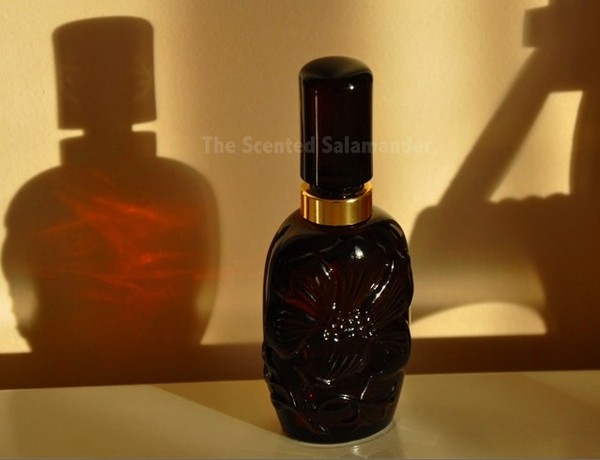Clinique Aromatics Elixir Perfumer's Reserve (2011): Extract This Contradiction {Perfume Review & Musings} {New Fragrance}
To celebrate the 40th anniversary of the classic, urban, nervy, active, sporty and elegant chypre which is Aromatics Elixir, the brand decided to offer a limited luxury edition of the composition initially created by perfumer Bernard Chant, the author of that other reference chypre fragrance, Cabochard by Grès. His Aramis is also a masculine twist on the feminine Aromatics Elixir.
It is perfumer Laurent Le Guernec who was asked to set to the task of renewing our sensations associated with the original. To that effect, he hints at the idea that he was guided by a very contemporary tension: the desire of greater quality allied with the taste for greater freshness. He said,
“Aromatics Elixir is one of perfumery’s most dazzling compositions, ...It is referred to as a masterpiece because of the beauty of its formulation, the sumptuousness of its ingredients and its unforgettable sillage.
“I wanted Aromatics Elixir Perfumer’s Reserve to attest to the genius of the original, while yielding a fresh perspective. I hope that in Aromatics Elixir Perfumer’s Reserve, the woman who is addicted to the original will find a new way of experiencing her beloved Aromatics Elixir, while women who thought the original too potent will find this modern homage alluring.”...
Aromatics Elixir was advertized from the start as a "tonic", hypoallergenic perfume in keeping with the reconstructed apothecary tradition of the company. Now that tonic character is going in the direction of more freshness but in a concentration of perfume which is usually not used to that effect: the perfume extract.
Relying on a more classic outlook, a fragrance composition wanting to project greater quality in its extract version would be deeper, velvetier, and probably as a result, darker. Let me rephrase that, it would not "want to project greater quality" but be more qualitative. Buoyed by the sheer quality of its ingredients, it would just Be. It is therefore symptomatic, I realize, to say that there is here a greater work on the illusion of quality, justified in this case by the fact that freshness is to be part of that extract as a key note. How do you convey extract quality and lightness, freshness? It is not easy.
In the chypre genre, there is the possibility of developing the sensation of a golden luminosity as a substitute for the deep, absorbing folds of an extract thick with essences. The Perfumer's Reserve does not really play on that aspect as it visibly really wants to be more discreet and wearable.
Aromatics Elixir Perfumer's Reserve behaves like an extract - it has less (radiant) sillage than an eau de parfum - and in a sense is more muted, as when sound is prevented from travelling freely by heavy velvet curtains, but it is not a rich and decadent concoction as one might expect. Clinique actually offers a "parfum" version in a spray of the Aromatics Elixir, which means an "extract" in French, which is more projective and a bit more intense.
What the Perfumer's Reserve does is to recreate the mystique of the extrait, in part thanks to the gesture that you will use to put the perfume onto your skin: it's a dab bottle and the jus is housed in a gorgeous ambery flacon with a raised motif of flower. But also by subtly showcasing a few suggestive nuances, like a fecal-y, civet-y nuance as the fragrance dries down, which is a nod to the ancient speak of old-school extraits. Like fur on your shoulders, civet in your base notes scream opulence. Except now both are mostly no-nos as the real thing. Illusion again is necessary.
The perfume opens on a gorgeous rose tinged with the animality of jasmine, but also made still quite bracing thanks to green, geranium-like accents. The accord speaks the language of extrait without being as pronounced. A note of fresh white peach adds further freshness. The patchouli is earthy in the light and clean, new manner, thanks to molecular distillation technology from Laboratoire Monique Rémy. There is a certain headiness, but without the big volume normally associated with it. The myrrh softens the fragrance. The perfume is both fresher and darker, with a sustained top fresh accord making you think of freshly plucked flowers and then a more intense ambery body and chypré accord. There are discreet soapy nuances to create a subliminal sense of clean, but which are never overwhelming.
True to the spirit of a pure parfum it is more a work on quality, texture and staying power than on any added narrative twist to the story of the scent. The paradoxical aspect of this extract composition is that less is more. The development is simplified and more linear, it is lighter, yet there is a sense of research of artful new effects.
Perhaps the extraits and other prestige editions of the day will now be the Perfumer's Reserve in the sense of revealing the higher IQ power of perfume rather than its literal greater richness. Undeniably, Laurent Le Guernec approached his task with ideas. Jean-Claude Ellena exemplifies for me this tendency of the perfume as being the workroom of the perfumer (see Eau Claire des Merveilles.) Unlike Ellena, Le Guernec eschews the slightly more modernist feeling of unfinished work or gaping seams. But in a sense, it is quite perfumer-centric a composition, meant to be savored for what it does not do.
Notes: verbena, coriander, clary sage, chamomile, orange flower absolute, peach, Bulgarian rose, jasmine; muguet, and ylang-ylang, patchouli, oakmoss, sandalwood, orris, myrrh, vetiver, labdanum.
Quote: The Moodie Report










